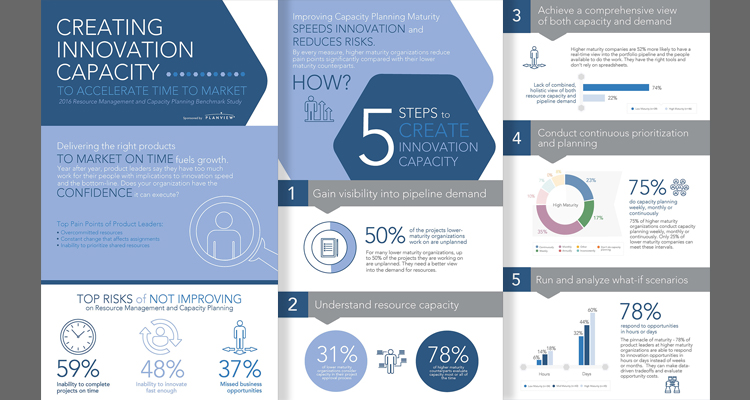
***Warning: These 12 Tips are provided to help you bring common sense to your organization’s resource planning. If your organization isn’t ready for common sense, proceed with extreme caution. But proceed nonetheless.***
In my roles both as author on the subject of project management and working here at Planview with our fantastic customers, I can tell you one thing always rings true: resource management ain’t easy.
As you may know, we just released a study based on a global survey on just this very topic. I found it fascinating that virtually all organizations say that doing capacity planning for better resource management is incredibly important, yet many add that it’s just too difficult to actually do!
So what stands between the saying and the doing? Because there’s a cost to that failure: more than 70% of organizations that do poor capacity planning overcommit their resources – which leads to a whole host of other issues.
In my experience, a lot of it comes down to common sense.
I was perusing some of my previous papers, and, lo and behold, I came across one that I like to think is an “oldie but goodie” that speaks directly to this. I’ve refreshed it with new some ideas and put some new polish on it.
I’m not going to claim that these 12 tips will instantly make everything easy. But I do think that they will help you leverage some good, old-fashioned common sense to cut through the complexity and the chaos. Of course, we know that common sense isn’t so common, so let’s call them:
My 12 Un-Common Sense Resource Planning Tips
1. Don’t Manage like Custer – It could be argued that, in the Battle of Little Bighorn, Lt Col George Custer made a few mistakes. First was rushing to battle instead of waiting for reinforcements. Second was splitting his forces. As a result, he was greatly outnumbered and suffered his famous defeat (not to mention, he died).
The lesson we can draw from this: don’t stack the odds impossibly high against your own people. Be sure you have adequate resources for your initiatives, and that you have at least a reasonable chance of success. You can do this by instituting Capacity Planning to consider available capacity at a high level when scheduling projects. Also, focus your resources on the most innovative and strategic initiatives without abandoning your support activities. This means making tradeoffs, perhaps seeking alternate staffing strategies. Remember, if it doesn’t work on paper, it won’t work in real life. This is probably the most common sense tip of all, and the least practiced.
2. Get (Real) Resourceful – Most organizations are operating with blinders on when it comes to resource availability. Make a point to look at the “true” picture of capacity (i.e., the available resource hours after all the administration, time off, and estimated unplanned or support work is considered). Likewise with demand: look at the full spectrum of demand that’s competing for your resources’ time, not just major projects and programs. Then you won’t be “planning to infinite capacity,” as is so often the case.
3. Know What’s Coming – I mentioned it earlier, but: you can’t plan for capacity if you don’t know what you’re planning for. Understanding and managing demand lies at the heart of a solid capacity planning approach – it’s impossible to do the latter without having the former. Yet many organizations I’ve worked with lack all but the most glancing insight into demand. If this sounds familiar, take heart. Implementing a demand management process is not only common sense, it’s highly doable, and can additionally help you filter out wasteful, redundant, or low-value efforts. It can also assist with prioritization and scoring, to minimize resource conflicts and to allow for making tradeoffs when needed.
4. Spring Clean Your Processes – Bloated processes destroy productivity. Bring all the parties in your process together in a room and map out your end-to-end implementation process. Any redundancies or inefficiencies should become apparent. Try to replace excess approval steps with checklists where appropriate. Be open to suggestions, and be willing to challenge the necessity of each step and each data element.
5. Don’t Go It Alone – Since an organization is, in essence, an ecosystem, resource capacity planning should not be a singular activity done by an individual group or person, though they can facilitate the effort. It takes the involvement of department managers, since they’re the ones who know their resources best. No way around it, folks. When it comes to effective resource planning, it takes a village.
6. Get (Real) Strategic – Connecting strategy with execution is how your company makes good on its goals. Reality is that many organizations keep the spotlight on departmental execution, often disjointed from the company’s end game. It’s rare that a single business unit in isolation achieves enterprise strategic goals in today’s environment. Instead, take an integrated approach to strategy, one which spans all the people, functions, and departments that will need to come together to make the strategy real. This approach breaks down silos and better aligns resources with value delivery.
7. Start with the End: Adopt Outcome-Based Planning – Your people are typically performing work toward some specific end goal, whether it’s a consumer product, a new service, an internal change, or a new facility. Manage with the end in mind. This means aligning projects and other work with the products, applications, services, or other outcomes that they are meant to support. Apply lifecycles, attributes, financials, and roadmaps to each deliverable to keep work on track and increase transparency. This approach gives more visibility to milestones, and creates a customer- and market-driven culture. Moreover, it gives a truer picture of the cost and effort being applied toward the outcome(s).
8. Watch Your Constraints: Target the Bottlenecks – Generally, about 20% of your resources serve as bottlenecks across 80% of your discretionary work. These constrained resources, always in-demand and spread thin, become the logjams in your workflow. Make a point to identify these key resources everyone is competing for, and understand what sets them apart so you can train up others or hire others if needed. Meanwhile, schedule projects around their availability, stagger project phases, or consider alternate sourcing strategies.
9. Remember: Resources Are People, Too – Planning the availability and throughput of human beings is different than planning assembly of materials or assessing equipment capacity on a shop floor. Your resources each have individual strengths, work preferences, skills, and motivators. Get to know the people, not just the resources. Make sure your teams have an appropriate mix of goal-focused and people-focused individuals, among other traits needed for your initiatives. Be sure people are aligned with their strengths, and address the factors that impact morale.
10. Keep It Together: Integrate via Portfolios – With your personal finances, portfolios serve to align your investments with your goals. It is the same in business, but on a grander scale. Use portfolio management to align all the components in your delivery chain, including ideas, strategies, products, services, projects, resources, software applications, and other assets. This way, when change happens – and it will – it’s easier to see the impacts in a holistic fashion. It’s also easier to set and adjust to new strategies.
11. Analyze and Report, Right Now – Are strategic projects on track? Are they staffed adequately? What else are those people working on? Are resources and projects balanced appropriately across the right business units? These are things you must be able to quantify – now. No matter the situation, companies today expect you to know and show. It’s no longer enough to gather up last week’s spreadsheets; today’s executives demand real-time answers to both high-level and in-the-trenches queries, so if you don’t have a way to do this yet, get one. Even if your people are doing the right things, if you can’t demonstrate that they are, you’ll lose credibility.
12. Seek and Nurture Effective Leaders – Throughout history, countless business projects – and businesses – have failed because of a lack of effective leaders. Either there weren’t enough good ones to go around, succession planning was inefficient or nonexistent, or the leaders were mismatched to the culture of the organization. Make an effort to identify, develop, or acquire effective leaders. But resist the temptation to promote high performing “doers” to a leadership position solely based on their functional performance (i.e., the Peter Principle). Leadership is a unique skill comprising a rare combination of talents. And ineffective leadership is a prime barrier to resource productivity.
So there you have it: my 12 Un-Common Sense Resource Planning Tips for your common-sense resource capacity plans. They won’t solve all your problems, but I do believe that if you implement even a few of them, you’ll see the benefit.
What’s your take on my common-sense approach? Have I missed one (or more)? Let me know in the comments!




